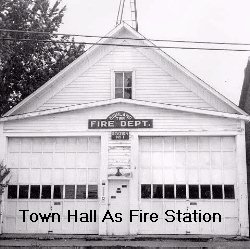The
Highland Township Historical Society |
|---|
BACK TO THE HISTORICAL RECORDS PAGE
Highland History Headlines
Although Samuel Durant's 1877 History of Oakland County, Michigan, gives a good description of Highland Township's original settlement and initial growth, that account is nevertheless more than a century old. While it is impossible to give a detailed history of Highland Township on this web site, the following chronology provides "bullet point" summaries of some of the more significant and/or interesting events not covered in Durant’s narrative. The principal source for these "Highland History Headlines" is Clara Mae Beach, Our Highland Heritage; a more comprehensive, illustrated history of the community published by the Highland Township Sesquicentennial Committee in 1986. References to that work are denoted as "OHH," followed by the relevant page numbers. Copies of Miss Beach's book are unfortunately no longer available for sale, but are included in the reference collection of the Highland Township Library, Michigan State Library and Burton Historical Collection.
Contents
1830-1880 1880-1889 1890-1899 1900-1909 1910-1919 1920-1929
1930-1939 1940-1949 1950-1959 1960-1969 1970-1979 1980-1989
1832 - On September 6th Naham Curtis becomes the first person to purchase land in what will become Highland Township. He makes but a brief stay, however, heading west with the Mormons circa 1836.
 1834 - On January 16th the (West) Highland Baptist
Church is organized in the log cabin home of Jesse Tenny, a pioneer settler.
The twelve original members worship at the Tenny home the rest of the winter until a
school is built on his farm later that year.
1834 - On January 16th the (West) Highland Baptist
Church is organized in the log cabin home of Jesse Tenny, a pioneer settler.
The twelve original members worship at the Tenny home the rest of the winter until a
school is built on his farm later that year.
1835 - On March 17th Highland is organized as a separate and distinct township by an act of the Michigan Territorial Legislature. The act further directs that the first town meeting is to be held at the school house on Jesse Tenny's farm; the same building used for worship by the West Highland Baptist Church.
1835 - On April 6th the first township meeting is
convened at the school on Jesse Tenny's farm pursuant to the Territorial Legislature's
directive. After election of a moderator and clerk, however, the meeting is quickly
adjouned to the home of Noah P. Morse (possibly to partake of "refreshments" not
available at the school?)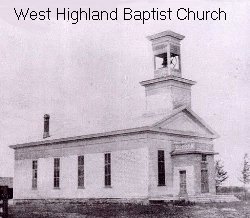
1835 - The Detroit Democratic Free Press for Sep. 16, 1835, carries an advertisement by the federal government soliciting bids to carry the mail to different points in Michigan. Among these is a "Special route" for "Highland to be supplied from Walled Lake, 9 miles, once a week." See: Territorial Papers of the United States, Vol. XII, Michigan Territory, p. 950.
1835-36 - The West Highland Cemetery is established, not far from the school and (later) church used by the West Highland Baptist Church.
1847 - After several years of worshiping at the school on the Tenny farm, the West Highland Baptist Church begins construction of a church building nearby, on what is now South Hickory Ridge Road. It is completed in 1852 and serves the congregation for the next 118 years before being demolished in 1970 to make way for a larger facility.
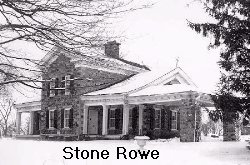 1854 - Squire Washington Rowe builds
“Stone Rowe,” a Greek-revival house made from native fieldstone. Located
on the north side of Lone Tree Road, between Milford and Hickory Ridge Roads, this elegant
home will later be designated a Michigan Historic Site in 1976.
1854 - Squire Washington Rowe builds
“Stone Rowe,” a Greek-revival house made from native fieldstone. Located
on the north side of Lone Tree Road, between Milford and Hickory Ridge Roads, this elegant
home will later be designated a Michigan Historic Site in 1976.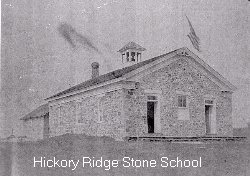
1856 - Early records show the existence of a Township Library by this time, with 512 books in its collection. This first Library was apparently discontinued between 1858 and 1861. OHH, p. 167.
1850-60 - A school house is built circa 1850-60 on the west side of Hickory Ridge Road, approximately one-half mile south of Clyde Road, on land originally given for a school in 1836 by Edmund Lockwood. The building is constructed in the Greek-revival style using local fieldstone and measures 30 by 40 feet.
1868 - The Freewill Baptist Church, organized in 1855, constructs a church building on the southwest corner of Hickory Ridge and Clyde Roads, on land donated to the church by Edmund Lockwood.
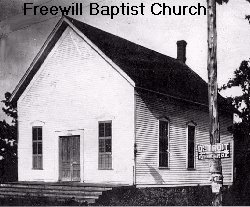 1871 - The Holly, Wayne & Monroe Railway is completed through
Highland Township. By May, 1872, the line is merged with and becomes known as the
Flint & Pere Marquette Railway.
1871 - The Holly, Wayne & Monroe Railway is completed through
Highland Township. By May, 1872, the line is merged with and becomes known as the
Flint & Pere Marquette Railway.
1872 - Completion of the railroad prompts Almon Ruggles
and Germain St. John to plat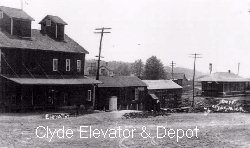 the village of Highland Centre,
just west of the tracks. Within a few years the post office is moved to the new
community from its original location at Spring Mills and the name of the village is itself
changed from Highland Centre to Highland Station, in recognition of the railroad's growing
importance.
the village of Highland Centre,
just west of the tracks. Within a few years the post office is moved to the new
community from its original location at Spring Mills and the name of the village is itself
changed from Highland Centre to Highland Station, in recognition of the railroad's growing
importance.
1875 - Julian Bishop, county surveyor, lays out the village of Clyde on behalf of Lyman Johnson, who purchased the land some years before. By the end of the decade the community boasts a post office, railroad depot, Western Union office, grain elevator, store and other amenities.
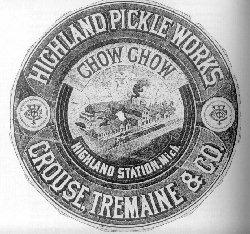 1881
- John Bernard ("J. B.") Crouse, Henry Tremaine and Solon Wilhelm form
Crouse, Tremaine & Co. and build a pickle factory in Highland Station on the south
side of East Livingston Road, just east of the railroad track, doing business under the
name "Highland Pickle Works." The plant employs numerous men and women and
provides a ready market for acres of cucumbers grown by local farmers, OHH, pp. 149-154.
1881
- John Bernard ("J. B.") Crouse, Henry Tremaine and Solon Wilhelm form
Crouse, Tremaine & Co. and build a pickle factory in Highland Station on the south
side of East Livingston Road, just east of the railroad track, doing business under the
name "Highland Pickle Works." The plant employs numerous men and women and
provides a ready market for acres of cucumbers grown by local farmers, OHH, pp. 149-154.
1881 - The firm of Palmer & Palmer lease land from the Flint & Pere Marquette Railroad on the south side of East Livingston Road, just west of the tracks, and construct a grain elevator.
1882 - J. B. Crouse and wife Betsey plat 50 lots in the
southwest part of Highland Station. Called the “Crouse Subdivision,” it
includes four new streets, i.e., McPherson, Clark, King and John. In 1883 Crouse
donates lots 1, 2 and 6 at the corner of West Livingston Road and John Street to the
Methodist Church, on which a sanctuary is later built in 1886. OHH, pp. 150-151.
1882 - The Highland Christian Association, composed largely of Congregationalists and Methodists, builds a church on the northeast corner of Centre Street (now Milford Road) and Ruggles Street in Highland Station. The Congregational members eventually assume full ownership, but permit the Methodists to continue using the building until their own church is completed in 1886. OHH, pp. 71-72.
1883 - William Smith Seaver purchases the Palmer & Palmer grain elevator, which he operates until 1909. OHH, p. 124-126.
 1886 - Records indicate the Highland
Township Library to have reorganized by this time, with 40 volumes added to its collection
this year. OHH, p. 167.
1886 - Records indicate the Highland
Township Library to have reorganized by this time, with 40 volumes added to its collection
this year. OHH, p. 167.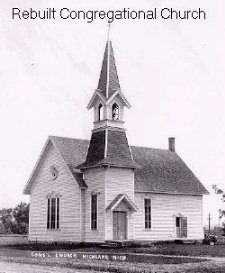
1886 - The Clyde Methodist Church building is constructed and remains in use until 1967 when the Clyde congregation merges with that at Highland Station. OHH, pp. 67-69.
1886 - The Methodist Episcopal Church of Highland Station is constructed on the lots donated by J. B. Crouse in 1883 and remains in use until 1981 when the congregation moves to a larger new facility and the original church building is acquired by Highland Township. OHH, pp. 67-69.
1886 - Efforts begin to drain Duck Lake and White Lake so as to create additional farmland for surrounding landowners. The project is abandoned by the early 1900's, however, once the recreational value of the lakes is recognized. OHH, p. 185, 187
1887 - Fire destroys the original Congregational Church building built in 1882. A new building is constructed on the same site later that year and remains in use until 1984 when the congregation moves to a larger new facility on North Hickory Ridge Road. OHH, pp. 72-73.
1890 - William Needham opens a new factory for his Domestic Pickle Works in Highland Station, near the current intersection of M-59 and Milford Road. OHH, p. 249.
1890 - Highland voters overwhelmingly approve construction of a new Town Hall, to be built on the south side of East Livingston Road, midway between Centre Street (Milford Road) and the railroad tracks. The building is completed by October 1st and serves as the Town Hall for the next sixty-three years. In addition to township business, the Hall also hosts school plays and concerts, dances, socials, public meetings, etc. OHH, pp. 163-164.
 1891 - Eugene B. Wilhelm acquires control of the Highland Pickle
Works and operates the factory under the name "Highland Vinegar and Pickle
Company" until 1892, when the failure of the Milford State Bank brings financial
ruin. OHH, pp. 155-156.
1891 - Eugene B. Wilhelm acquires control of the Highland Pickle
Works and operates the factory under the name "Highland Vinegar and Pickle
Company" until 1892, when the failure of the Milford State Bank brings financial
ruin. OHH, pp. 155-156.
1893 - On December 16 the Wells-Stone Mercantile Company of Saginaw, Michigan, purchases the Highland Vinegar and Pickle Company factory and renames it the Oakland Vinegar and Pickle Company. OHH, pp. 156.
1894 - In March a fire destroys L.C. Johnson's store,
hotel and house at Clyde. Located at the corner of Railroad Street and Main Street
(now Milford Road), the store and attached hotel had been built in 1873, replacing the
first store ever built in Clyde in 1871. OHH, p. 259.
1894 - In July a fire destroys the Needham Domestic Pickle Works factory, but it is rebuilt by October. OHH, p. 250.
1896 - In June a fire destroys the Oakland Vinegar and Pickle Company works, originally built by Crouse, Tremaine & Co. in 1880-81. OHH, pp. 157-159.
1897 - William Needham relocates his Domestic Pickle Works factory to the site of the burned-out Oakland Vinegar and Pickle Company facilities, on the south side of East Livingston Road. OHH, p. 250.
1898 - In March Lester St. John builds a large windmill, with a wheel 26 feet, 10 inches in diameter, to power his lumber mill on St. John Street, just north of East Livingston Road. It is reputed to be one of the finest windmills of its kind in the country. OHH, pp. 56, 58.
1898 - In November the Milford Times reports that a show of "living" moving pictures (i.e., movies) given at the Highland Township Hall was well-attended. OHH, p. 199.
1900 - Highland residents begin to establish family camp grounds on the shores of the Township's major lakes. Summer cottages are eventually constructed which quickly begin to attract "resorters" from all over the Midwest. OHH, 185-186.
1902 - Rural Free Delivery commences from Highland Station in July. The route runs west to Hartland and covers the western part of the township. In September a second RFD route begins operating from the post office at Clyde.
1905 - Highland resident Charles "Uncle Charlie" Porter is named the oldest man in Oakland County, at age 104. An Englishman by birth, Porter came to Highland after serving in the Civil War. He dies later in 1905. OHH, pp. 308-310.
1906 - The Post Office at West Highland (formerly called Highland Corners and, before that, Highland Post Office) is discontinued. Mail to the southwestern part of the Township is thereafter delivered by the Post Office in Milford and continues to be so to the present (2003).
1906 - In January a fire - believed caused by sparks from a passing train - destroys William Needham's new Domestic Pickle Works factory and spreads to his nearby residence. The factory is later rebuilt and a new home erected on the site, OHH, p. 250-251; 261.
1908 - In May a fire destroys the Clyde railroad depot and freight house. The depot is later rebuilt and continues to serve the Clyde community until its closure in the mid-1930's. OHH, p. 257.
1909 - Charles Atkin purchases the grain elevator at Highland Station from William Smith Seaver, OHH, p. 126.
 1911 - Josiah Hair purchases the William
Martin farm at the north end of Dunham Lake, where he and son Burchard R. Hair begin to
manufacture the "Liberty Fire Extinguisher." These long tin tubes, filled
with a fire-suppressing powder, are hung by a nail or hook near the stove or
fireplace. In the event of a fire the homeowner would pull on the tube, removing its
cap, and sprinkle the powder over the flames to smother them. The
"Liberty Fire Extinguisher" proves quite popular; especially with
insurance agents who give them to their policy holders as promotional
"premiums." Examples can still be found in antique shops throughout
Michigan and Ohio, all clearly labeled as made by "The Liberty Fire Extinguisher Co.,
Highland, Michigan." OHH, p. 147.
1911 - Josiah Hair purchases the William
Martin farm at the north end of Dunham Lake, where he and son Burchard R. Hair begin to
manufacture the "Liberty Fire Extinguisher." These long tin tubes, filled
with a fire-suppressing powder, are hung by a nail or hook near the stove or
fireplace. In the event of a fire the homeowner would pull on the tube, removing its
cap, and sprinkle the powder over the flames to smother them. The
"Liberty Fire Extinguisher" proves quite popular; especially with
insurance agents who give them to their policy holders as promotional
"premiums." Examples can still be found in antique shops throughout
Michigan and Ohio, all clearly labeled as made by "The Liberty Fire Extinguisher Co.,
Highland, Michigan." OHH, p. 147.
1911 - In February an explosion in the basement damages the store run by Frank S. Keller and I. Roy Waterbury on the northeast corner of Centre Street (now Milford Road) and East Livingston Road. OHH, pp. 271-272.
1911 - In June a faulty gasoline lamp starts a fire which destroys the store of Sidney W. Hulbert, located on the southeast corner of Centre Street (now Milford Road) and East Livingston Road. The building, which also housed the local Bell Telephone switchboard, is a total loss. A new store is rebuilt by September. OHH, pp. 268-270.
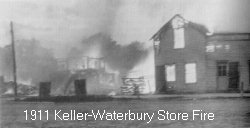 1912 - On
June 1st a faulty gasoline lamp starts a fire in the Keller and Waterbury store on the
northeast corner of Centre Street (now Milford Road) and East Livingston Road, little more
than a year after the explosion in 1911. The entire building is soon engulfed in
flames, which then spread north and east, destroying or damaging several other homes and
businesses. The fire ranks as one of the worst experienced in the Township.
OHH, pp. 272-273.
1912 - On
June 1st a faulty gasoline lamp starts a fire in the Keller and Waterbury store on the
northeast corner of Centre Street (now Milford Road) and East Livingston Road, little more
than a year after the explosion in 1911. The entire building is soon engulfed in
flames, which then spread north and east, destroying or damaging several other homes and
businesses. The fire ranks as one of the worst experienced in the Township.
OHH, pp. 272-273.
1913-14 - William Needham buys the land formerly occupied by the burnt Keller and Waterbury store, together with adjoining properties on the northeast corner of Centre Street (now Milford Road) and East Livingston Road. He builds a new, larger store which is thereafter managed by his son Charles. OHH, pp. 251, 273.
1914 - Charles Atkin sells the grain elevator at Highland Station to Frank Keller. OHH, p. 127.
1919 - Frank Keller proposes formation of a farmers' cooperative to own and operate the grain elevator at Highland Station. The resulting Highland Producers Association successfully runs the facility until 1979, when it associates with the Farm Bureau and merges with Farmers Petroleum. OHH, pp. 127-129.
 1927 - The Oakland County Road Commission opens a garage on North
St. John Street to house trucks, graders and other equipment used to maintain the roads in
western Oakland County. While no longer a Road Commission facility, the building
still stands (2003).
1927 - The Oakland County Road Commission opens a garage on North
St. John Street to house trucks, graders and other equipment used to maintain the roads in
western Oakland County. While no longer a Road Commission facility, the building
still stands (2003).
1928 - Highland voters approve a 1/4 mill tax to fund a reoganized Highland Township Library with an elected board of directors. OHH, p. 169.
1929 - In May a fire destroys the ice houses owned by the McFadden Ice Company on Upper Pettibone Lake, just south of Clyde. A dormitory which housed 100 men during the ice cutting season is also destroyed, together with some 14,000 tons of stored ice.
1930 - On the night of November 7 a fire destroys the historic Hickory Ridge stone school built circa 1860. A replacement wood frame building is constructed and ready for use by January 1, 1931.
1938 - Construction begins on State Highway M-59 through Highland. Running from Mt. Clemens to Howell, it passes through the township just north of Highland Station. The portion between Harvey Lake Road and Milford Road roughly follows the west half of former Spring Mills Road. The grading necessary to build the viaduct under the C & O railroad tracks forces closure of the two-room Highland School (District No. 4). As compensation, the State Highway Department helps fund construction of a new brick school building on North John Street (now part of Highland Middle School). OHH, p. 278.
1941 - The 1890 Township Hall is remodeled and provided with garage doors on the north end to house the Township's first fire truck. The building continues to be used as a fire hall until 1969. OHH, p. 164.
1944 - Highland native Pfc. Melvin C. Heffelbower, Jr., a member of Company D, 2nd Ranger Infantry Battalion, is killed in action on D-Day, June 6, 1944, as his unit stormed Omaha Beach in Normandy, climbing the cliffs to destroy the German guns at Pointe du Hoc.
1946 - Howard Armstrong officially opens the Armstrong Millworks for business. The company remains a family-run corporation, operated by two of Howard's sons and employing two of his grandsons.
1953 - A new Township Hall is built on North John
Street. The Township Library is given the use of a room on the north side to house
its collection of books. The original 1890 Town Hall continues to be used as a
fire station for the next 16 years, OHH, p. 169.
books. The original 1890 Town Hall continues to be used as a
fire station for the next 16 years, OHH, p. 169.
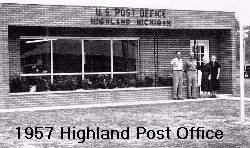 1956 - In March a sudden afternoon
"cloudburst" floods M-59 under the railroad viaduct, trapping three cars in
7-plus feet of water. The drivers all escape without injury, but their cars remain
submerged until later that evening when the waters finally recede, Milford Times,
Mar 7, 1956.
1956 - In March a sudden afternoon
"cloudburst" floods M-59 under the railroad viaduct, trapping three cars in
7-plus feet of water. The drivers all escape without injury, but their cars remain
submerged until later that evening when the waters finally recede, Milford Times,
Mar 7, 1956.
1957 - The post office moves from its original location on East Livingston Road, by the railroad, to a new and larger facility on North John Street. The building still stands as the auditorium of the current Highland Township Hall.
1962 - The Township Library moves to a larger room on the south end of the Township Hall. OHH, p. 170.
1962 - The Needham family pickle factory, begun by William Needham, Sr., as the Domestic Pickle Works, ceases operation.
1969 - The Highland Fire Department vacates the 1890 Town Hall building and moves into new "Station No. 1" on the northwest corner of West Livingston Road and John Street. The old Town Hall building is sold by the Township and is eventually used as an auto repair facility. OHH, p. 164.
1970 - The West Highland Baptist Church building, begun in 1847 and completed in 1852, is torn down to make way for a larger new facility on the same site. Located on South Hickory Ridge Road, the West Highland Baptist Church is the oldest religious society in the Township, having been organized in 1834. OHH, pp. 61-64.
1972 - The Post Office vacates its 1950's era building on North John Street and moves into a newer facility immediately south of the old one. The vacated building is acquired by the Township and incorporated into the Township Hall complex, serving as an expanded room for the Township Library. OHH, p. 170.
1980-81 - The Highland United Methodist Church moves from its historic 1886 church building on West Livingston Road to a larger, new facility further west. The original church building is acquired by Highland Township and renovated for use by the Township Library. The former "Library Room" at the Township Hall complex (originally the 1950's era Post Office) becomes the Township Hall Auditorium.
1981-83 - State Highway M-59 is widened from two lanes to a four-lane boulevard.
1983 - Cornerstone Bible Church is formed in the former Free Will Baptist Church building on North Hickory Ridge Road.
1983 - In September the "Lone Tree" - a
massive, 250-year old white oak for which Lone Tree Road was named - is cut down in the
interest of highway safety. It formerly stood on the southwest corner of the
intersection of Lone Tree and Milford Roads. OHH, p. 360
1985 - Highland Township celebrates its sesquicentennial. The Highland Township Sesquicentennial Committee publishes Clara Mae Beach's township history, Our Highland Heritage.
1988 - The National Campers and Hikers Association (NCHA) hold their 28th annual "Campvention" at Highland State Recreational Area. News of the planned event initially cause some to worry that the large number of visitors might result in harm to the park's undeveloped natural areas, but such concerns prove largely unfounded.
1996 - Lifelong Highland resident, Clara Mae Beach, author of Our Highland Heritage, dies at age 89. The Beach family sells 35 acres of the family farm, on the north side of M-59, to the Township for use as a new municipal complex.
2001 - Cornerstone Bible Church builds a new sanctuary seating 1000 worshipers. The former Freewill Baptist Church building becomes a youth center.
2002 - In June the Highland Township Public Library dedicates its new building overlooking the shores of Downey Lake on the former Beach property.
2003 - Highland is among countless Michigan communities hit by the "Great Blackout of 2003;" a failure of the electrical grid which knocked out power to several states in the midwest and northeast. Power was lost just after 4:00 p.m. on August 14th, but was largely restored by noon the following day.
2003 - Two residents of Crapo Street, in the historic Highland Station district, are "embarrassed" when others mispronounce the name and so ask to have it changed. The story is soon picked up by the media, with items appearing in the Milford Times, the Detroit Free Press (Nov 17, 2003), and USA Today, as well as on CNN and the Paul Harvey radio show. Citing Governor Henry H. Crapo's important role in bringing the railroad through Highland, the Highland Township Historical Society unanimously passes a resolution opposing elimination of "Crapo," but does suggest adding the "Governor" to the street's name. The Highland Township Board and Road Commission for Oakland County adopt the Society's suggestion and change the name to Governor Crapo Street. For the history behind the name of Crapo Street, click this link to see its entry in the "Highland Township Gazetteer."
2006 - In August Township residents celebrate the 120th birthday of the "Highland Station House" - former home of the Highland Methodist Episcopal Church and later the Highland Township Library. Built in 1886, the building now serves as home to several community groups, including the Highland Senior Citizens Center, Huron Valley Arts Council, Highland Downtown Development Authority and Highland Historical Society. Click this link for a DVD documenting this event, as well as other aspects of Highland history.
2007 - Highland loses some important pieces of its heritage with the demolition of several historic structures, including the former Freewill Baptist Church at the corner of Hickory Ridge and Clyde Roads. Built in 1868, it was the oldest public building still standing in the Township. In Highland Station, a small but achitecturally interesting 19th century stone smokehouse was torn down to facilitate access to new development on Milford Road. It formerly stood adjacent to the farmhouse owned owned by Germain St. John, one of the founders of Highland Station.
2007 - In October Highland residents are shocked when, on three separate occasions, vandals topple and/or deface several dozen tombstones in the Highland Centre Cemetery. A number of historic 19th century monuments are among those broken. The Highland Township Historical Society joins with several local businesses in donating funds to restore the damage. Two teenaged girls are later charged with the crime.
2009 - June saw the unveiling of a new historic marker commemorating the saw mill, grist mill and cider/vinegar mill which once stood in the Village of Spring Mills. The marker was presented to the township by the Pettibone Creek Chapter of Questers, International, and is located on the grounds of the Highland Township Public Library, just west of the old grist mill site. For more on this marker click this link.
